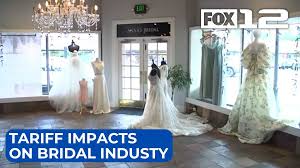
How Current US Tariffs Are Affecting The Bridal Industry
Share
Introduction: A New Challenge for Brides and Bridal Businesses
Planning a wedding is a significant milestone, filled with excitement and anticipation. However, recent developments in U.S. trade policy have introduced new challenges for brides-to-be and the bridal industry. The imposition of substantial tariffs on imported goods, particularly from China, has led to increased costs for wedding dresses and related items. This article explores the impact of these tariffs on the bridal industry and offers guidance for navigating this evolving landscape.
The Impact of Tariffs on Wedding Dress Prices
Significant Price Increases
The U.S. government's decision to impose tariffs as high as 145% on imports from China has had a profound effect on the bridal industry. Given that approximately 90% of wedding gowns are manufactured in China, these tariffs have led to substantial price hikes. Retailers report that the cost of wedding dresses has doubled in some cases, with gowns that previously retailed for $2,000 now priced at over $4,000 .
Challenges for Bridal Retailers
Bridal retailers, especially small businesses, are grappling with the increased costs resulting from these tariffs. Many are faced with the difficult decision of either absorbing the additional expenses or passing them on to customers. Some have opted to add a separate line item on receipts labeled "tariff surcharge" to transparently communicate the reason for price increases . Others are exploring alternative sourcing options, though shifting production away from China presents its own set of challenges.
Supply Chain Disruptions and Limited Alternatives
Dependence on Overseas Manufacturing
The bridal industry's reliance on overseas manufacturing, particularly in China, is due to the specialized labor and intricate craftsmanship required for wedding gowns. The U.S. currently lacks the infrastructure and skilled workforce to produce these garments domestically at scale. As a result, the tariffs have disrupted established supply chains, leading to delays and uncertainty in the availability of wedding dresses .
Efforts to Diversify Production
In response to the tariffs, some larger bridal retailers have begun diversifying their production to countries like Vietnam, the Philippines, and India. For instance, David's Bridal has reduced its China-based production from over 50% to about 30%, aiming to mitigate the impact of tariffs on their pricing . However, such transitions require time and resources, and smaller retailers may find it challenging to make similar shifts.
Implications for Brides-to-Be
Budgetary Concerns
The increased costs associated with wedding dresses due to tariffs have significant implications for brides-to-be. Many are finding that their dream gowns now exceed their budgets, leading to difficult choices and compromises. Some brides are opting for simpler designs, exploring secondhand options, or considering alternative attire to stay within their financial means .
Importance of Early Planning
Given the current uncertainties, early planning has become more crucial than ever. Brides are advised to start shopping for their wedding dresses well in advance to avoid potential price hikes and ensure availability. Locking in prices and placing orders early can help mitigate the risk of unexpected costs due to tariffs.
Strategies for Navigating the Tariff Landscape
Open Communication with Retailers
Brides should maintain open communication with their chosen bridal retailers to understand how tariffs may affect their purchases. Retailers can provide insights into potential price changes, alternative options, and timelines for ordering and delivery.
Exploring Domestic Designers
While the U.S. may not have the capacity for large-scale production of wedding gowns, there are domestic designers and boutiques that offer unique, handcrafted dresses. Supporting local businesses can be a way to avoid tariff-related issues and contribute to the local economy.
Flexibility and Adaptability
Flexibility in dress choices, wedding dates, and budgets can help brides navigate the challenges posed by tariffs. Being open to different styles, materials, and sourcing options can lead to creative solutions that align with both personal preferences and financial considerations.
Conclusion: Staying Informed and Proactive
The imposition of tariffs on imported goods has introduced new complexities to the bridal industry, affecting both retailers and brides-to-be. By staying informed about these developments and adopting proactive strategies, brides can navigate the challenges and still achieve their dream weddings. Open communication with retailers, early planning, and flexibility in choices are key to managing the impact of tariffs on wedding preparations.
